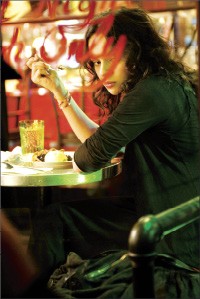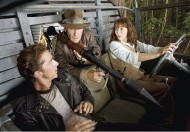Maudlin, sluggish, bland, and undeniably sincere, M. Night Shyamalan’s The Happening is a change of pace when set against the extravagant, hollow-brained mayhem of Iron Man and The Incredible Hulk. But its inadequacy and clumsiness as a work of entertainment, much less a work of art, make it as forgettable and regrettable as every other summer blockbuster so far.
The Happening opens in “Central Park, New York City, 8:33 AM”: A Day Like Any Other has begun. However, once the wind in the trees picks up, mundane everyday existence is disrupted. People begin to freeze, repeat themselves, and walk backward. Then the really odd stuff occurs, as citizens stab themselves with hairpins, fling themselves from rooftops, and kill themselves without compunction or reason.
News of these strange goings-on in New York travel quickly to Philadelphia, where strident, mystical science teacher Elliot Moore (Mark Wahlberg) is one of the many teachers at his school told to cancel classes and leave town. As the mysterious “toxin” causing the deaths continues to envelop the Northeast, Moore takes his skittish wife Alma (Zooey Deschanel), his math-teacher friend Julian (John Leguizamo), and Julian’s daughter Jess (Ashlyn Sanchez) away from the big city and into the country. Once they’ve supposedly outrun the threat, they land in Filbert, Pennsylvania, where Moore says to Jess, “We’re in a small town. Nothing can happen to us here.” Needless to say, Elliot is soon proven wrong.
When evaluating a movie that relies so much on genre conventions for its emotional effects, a telling comparison with another artist can be useful. The Happening is a dreary, shuffling homunculus compared to Steven Spielberg’s brilliant 2005 retelling of War of the Worlds. Like The Happening, War of the Worlds raided the same cellar of apocalyptic sci-fi clichés (ominous yet perspicacious news bulletins, hillbilly survivalist weirdos, threatening open spaces) but achieved far more subtle and horrifying emotional effects. Ironically, in 1999, Newsweek declared Shyamalan “the New Spielberg” based on the success of Shyamalan’s film The Sixth Sense.
A decade later, Newsweek‘s proclamation looks ridiculous. Shyamalan’s work has gotten more uncertain, gimmicky, and tentative since then, while Spielberg has been on a magnificent creative roll since 2001’s AI: Artificial Intelligence. Even Indiana Jones and the Kingdom of the Crystal Skull, Spielberg’s worst movie of the decade, has moments of visual élan (the car reflected in the hubcap, Indy regarding a mushroom cloud) that Shyamalan has never approached.
The chief source of interest in this film comes from watching Shyamalan try to cast off his image as Mr. Twist Ending and become a more serious artist, whatever that means. This split is most evident in the contrasting ways the director handles large spectacles and more intimate moments. There’s a misguided classical feel to the violent set pieces. Shyamalan often uses out-of-focus background events and offscreen sound to suggest rather than show the horrible effects of the airborne menace. Yet he goes in the opposite direction when he’s directing actors, using scores of extreme close-ups that repeatedly and erroneously equate camera proximity with emotional intimacy. These are mistakes that the person he was supposed to replace in the film world has long since outgrown.
The Happening
Now playing
Multiple locations

